


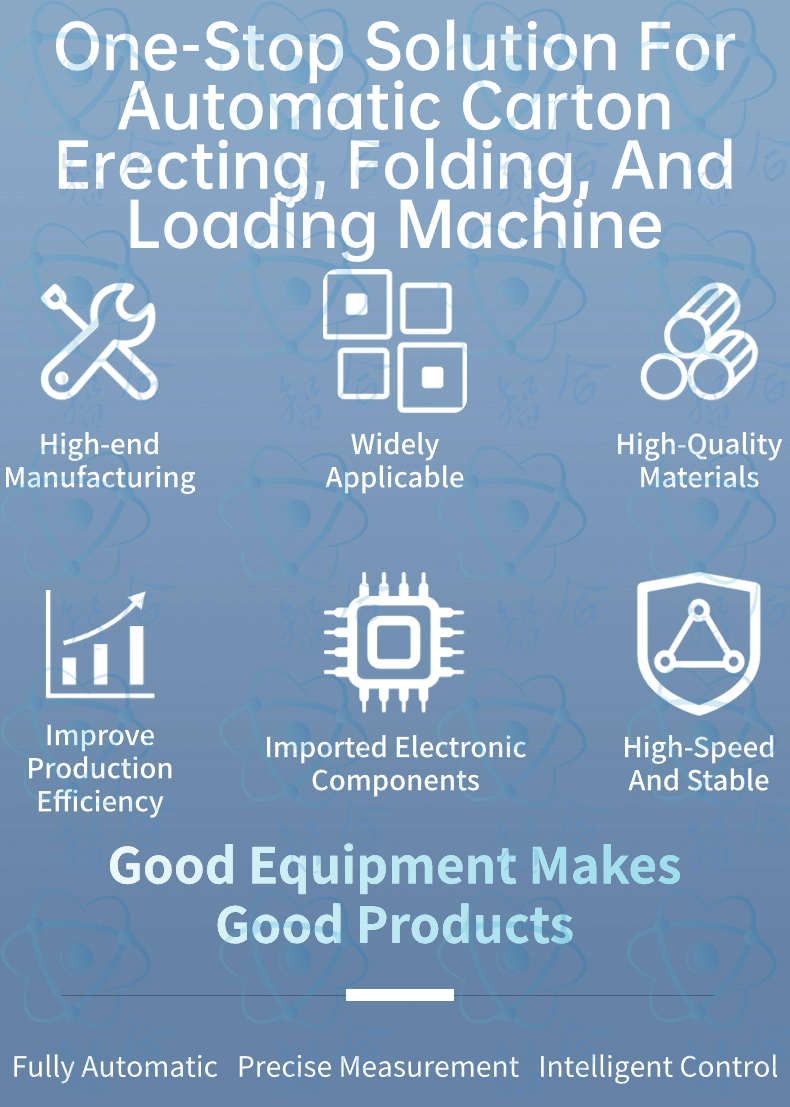

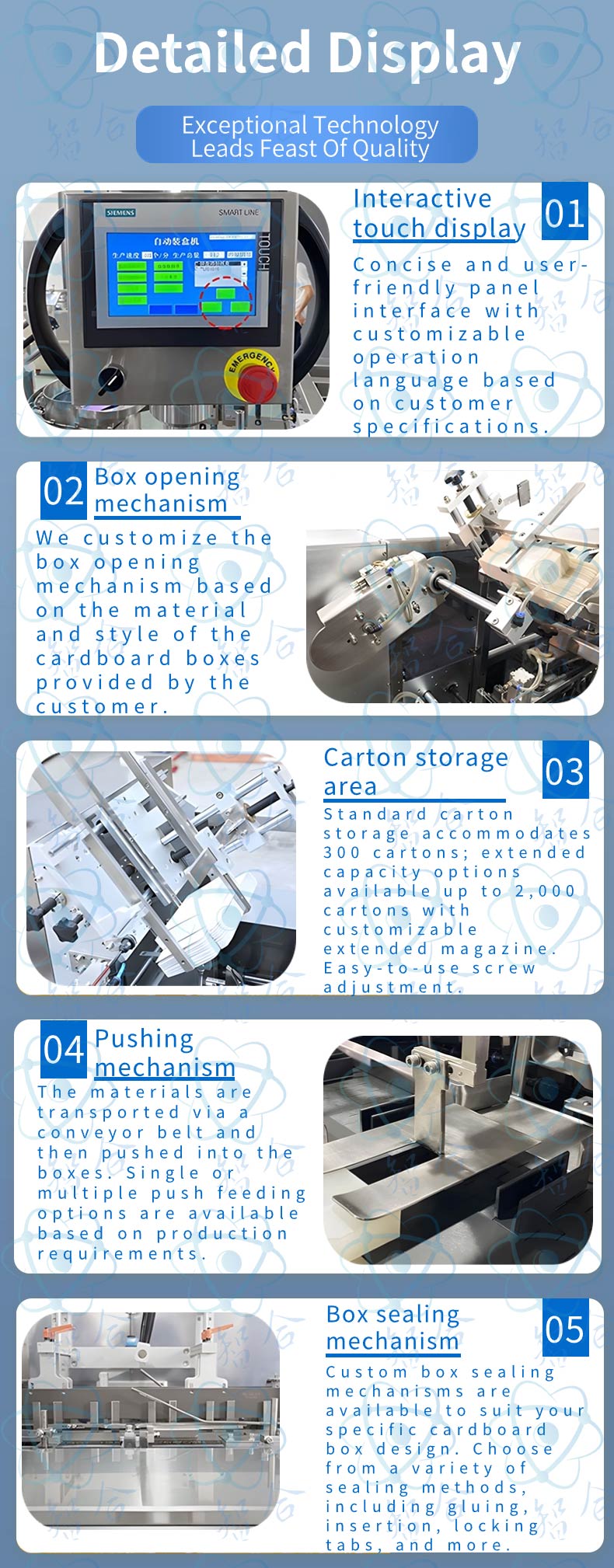
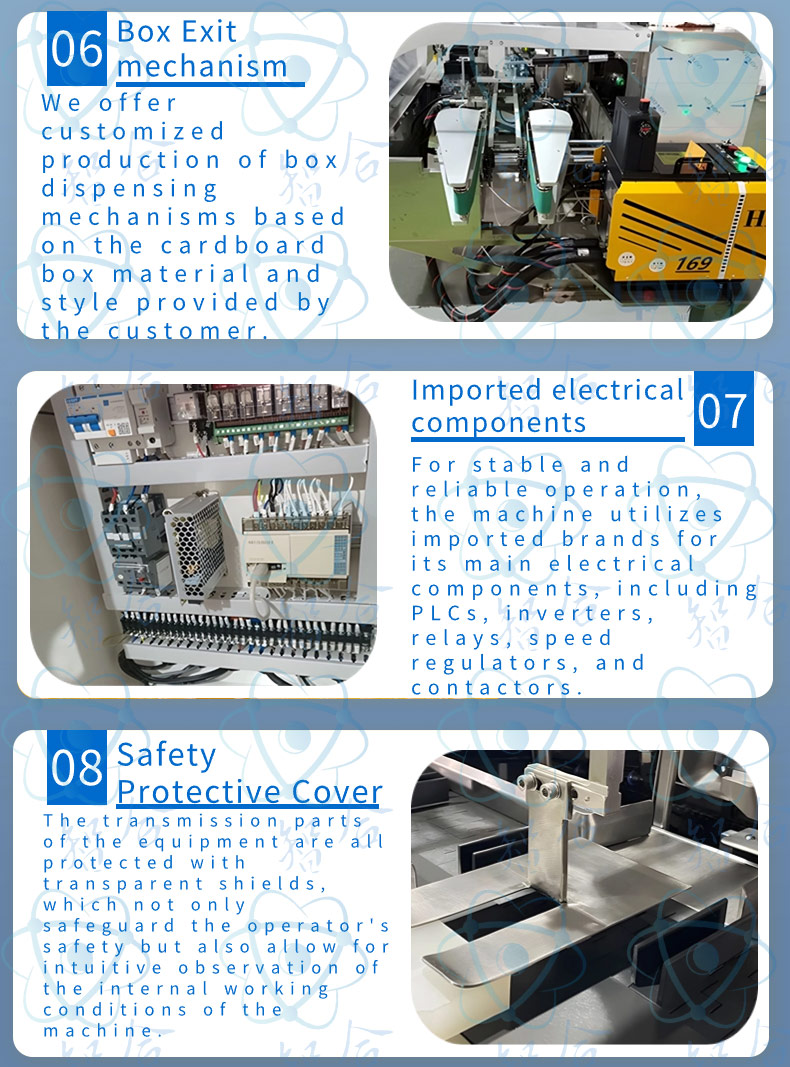 Fully Automatic Paper Box Forming, Folding, and Cartoning Machine details
Fully Automatic Paper Box Forming, Folding, and Cartoning Machine details
The fully automatic paper box forming, folding, and cartoning machine is a highly integrated automated piece of equipment designed to continuously complete the entire process from cardboard blanks to finished packaged boxes, including box forming, folding, and product insertion. This machine plays a vital role in modern industrial production, especially in industries requiring high-volume, high-efficiency packaging, such as food, pharmaceuticals, cosmetics, electronics, and daily consumer goods. To gain a more detailed understanding of this machine, we will delve into its structural components, working principles, key functional modules, technical advantages, and application areas.
I. Overall Machine Structure and Components
A fully automatic paper box forming, folding, and cartoning machine typically comprises the following main parts, which work collaboratively to complete the entire packaging process:
1. Cardboard Feeding Mechanism: This is the starting section of the machine, responsible for feeding stacked cardboard blanks (usually flat cardboard that has been die-cut and creased) one by one and accurately to the subsequent forming station. The design of the feeding mechanism is crucial, requiring stable and precise feeding to avoid double sheets or missed sheets, which would affect production efficiency and quality. Common feeding methods include vacuum suction feeding and friction feeding.
2. Box Forming Station: At this station, the cardboard blank is shaped into the intended box form. Depending on the box design, forming methods vary. Common forming methods include:
o Mold Forming: Using pre-designed molds, driven by mechanical or pneumatic pressure, the cardboard is bent and folded according to the mold shape to create the basic box framework. The precision of the mold directly affects the forming quality of the box.
o Suction Cup and Robotic Arm Forming: Using vacuum suction cups to pick up the cardboard, and robotic arms or linkage mechanisms for precise folding, combined with glue or heat sealing to seal and form the final box shape. This method offers higher flexibility and can adapt to different box sizes and shapes.
3. Box Folding Station: If the formed box requires further folding, such as folding side flaps or inserting locks, it proceeds to the folding station. This station is typically equipped with various folding mechanisms, such as:
o Mechanical Flap Folding Mechanism: Through a series of guide rails, rollers, folding plates, and other mechanical components, the box flaps are guided to fold along a predetermined path and finally fixed.
o Pneumatic or Hydraulic Folding Mechanism: Using pneumatic or hydraulic cylinders to drive folding components to achieve fast and precise folding actions.
4. Product Cartoning Station: This is one of the core functions of the machine, responsible for accurately and systematically loading products to be packaged into the formed and folded boxes. Product cartoning methods are diverse and need to be selected based on product characteristics and packaging requirements:
o Manual-Assisted Cartoning: For products with irregular shapes or requiring special placement, manual assistance may be needed to place products onto a conveyor belt or hopper, and then robotic arms or pushing mechanisms are used to load products into boxes.
o Automatic Feeding System Cartoning: For regularly shaped products, such as bottled, bagged, or boxed products, an automatic feeding system can be used, such as conveyor belts, vibratory bowls, aligning machines, etc., to arrange products systematically and transport them to the cartoning station. Then, mechanical devices (e.g., push plates, pick-and-place robotic arms) accurately load products into boxes.
o Top Loading, Side Loading, Bottom Loading: Based on the box opening position and product loading direction, cartoning methods can be categorized into top loading (products loaded from the top of the box), side loading (products loaded from the side of the box), and bottom loading (products loaded from the bottom of the box), etc.
5. Box Closing/Sealing Mechanism: After products are loaded into boxes, to ensure packaging integrity and sealing, the boxes usually need to be sealed. Box sealing methods are also varied:
o Glue Sealing: Applying glue (hot melt adhesive or cold glue) to the box flaps at the sealing area, and then using mechanical pressing to bond the box flaps together. Glue sealing is advantageous for its strong sealing and relatively low cost.
o Self-Locking Structure Sealing: Utilizing the box’s structural design itself, sealing is achieved by mechanical folding or inserting locking tabs, without the need for glue or tape. This method is environmentally friendly and easy to operate.
o Heat Sealing or Ultrasonic Sealing: For boxes made of special materials (e.g., laminated cardboard boxes), heat sealing or ultrasonic sealing can be used, utilizing heat or ultrasonic energy to fuse the box sealing area.
o Tape Sealing: Using tape to seal the box, which is simple and quick to operate and suitable for various types of boxes.
6. Output Conveying Mechanism: After completing cartoning and sealing, the finished packaged boxes are conveyed out of the machine via the output conveying mechanism. This can be connected to subsequent packaging lines, such as inkjet printers, labelers, case packers, palletizers, etc., to achieve higher-level automated packaging. Common output conveying methods include conveyor belts and roller conveyors.
7. Control System: The core control section of the fully automatic paper box forming, folding, and cartoning machine. It typically uses a PLC (Programmable Logic Controller) as the main controller, combined with a touchscreen operation interface (HMI), to monitor the overall machine operating status, parameter settings, fault diagnosis, and alarms. Advanced control systems may also have remote monitoring, data acquisition, and analysis functions to achieve intelligent management.
8. Safety Protection Devices: To ensure operator safety and normal machine operation, the machine is equipped with various safety protection devices, such as safety light curtains, safety doors, emergency stop buttons, and overload protection devices.
II. Machine Working Principle
The working principle of a fully automatic paper box forming, folding, and cartoning machine can be summarized in the following continuous steps:
1. Cardboard Feeding: The cardboard feeding mechanism separates stacked cardboard blanks one by one and accurately feeds them to the forming station.
2. Box Forming: At the forming station, the cardboard blank is bent, folded, glued, or locked into the intended box shape through mold or robotic arm operations.
3. Box Folding (Optional): If the box design requires further folding, it enters the folding station, where mechanical mechanisms perform precise box folding.
4. Product Feeding (Optional): Depending on the product characteristics and cartoning method, an automatic feeding system may be configured to systematically feed products to the cartoning station.
5. Product Cartoning: At the cartoning station, robotic arms, push plates, or other mechanisms accurately load products into the formed and folded boxes.
6. Box Sealing: After product loading, the sealing mechanism seals the box, ensuring packaging integrity and sealing.
7. Finished Product Output: Finished packaged boxes after cartoning and sealing are conveyed out of the machine via the output conveying mechanism, entering subsequent packaging stages.
8. Control and Monitoring: The PLC control system coordinates the actions of each station and monitors the machine’s operating status in real-time, ensuring automated, efficient, and stable operation of the entire packaging process.
III. Detailed Explanation of Key Machine Functional Modules
To further understand the machine’s performance and characteristics, we also need to understand some key functional modules in detail:
1. High-Precision Cardboard Separation and Feeding System: To ensure stable and accurate feeding, high-end machines typically use servo-controlled vacuum suction feeding systems. These systems can precisely control cardboard pick-up, separation, and feeding, effectively avoiding double sheets, missed sheets, and skewing, ensuring smooth subsequent processes.
2. Fast and Efficient Box Forming Technology: Forming speed is one of the important indicators for measuring machine performance. Advanced machines adopt modular, high-efficiency forming molds and fast-acting mechanical mechanisms, combined with servo drive systems, to achieve high-speed and stable box forming, improving production efficiency. For complex box shapes, multi-station, multi-step forming technology may be used to ensure forming quality and precision.
3. Flexible and Diverse Product Cartoning Methods: To adapt to the packaging needs of different products, the machine needs to have flexible and diverse cartoning methods. For example, for bottled products, pick-and-place robotic arms combined with conveyor belts can be used for horizontal or vertical cartoning; for bagged products, push plates or lever mechanisms can be used for systematic cartoning; for bulk products, vibratory bowls or aligning machines can be used for aligning and quantitative cartoning. Some high-end machines also have the ability to quickly switch cartoning methods to adapt to rapid product changeover needs.
4. Precise and Reliable Box Sealing Mechanism: Sealing quality directly affects the product’s appearance and protection performance. To ensure precise and reliable sealing, machines typically use high-precision gluing systems, uniform pressing mechanisms, and stable sealing methods. For high-speed production lines, fast-curing hot melt adhesives or efficient heat sealing technology may be used to improve sealing efficiency and quality.
5. Intelligent Control and Monitoring System: Modern fully automatic paper box forming, folding, and cartoning machines are increasingly focused on intelligence and informationization. Advanced control systems not only enable automatic machine operation but also have the following functions:
o User-Friendly Human-Machine Interface: Using large-size touchscreen operation interfaces, graphically displaying machine operating status, parameter settings, and fault information, making operation simple and intuitive.
o Parameter Memory and Recall: Parameter settings for multiple products and boxes can be pre-stored, facilitating rapid production switching and reducing debugging time.
o Fault Self-Diagnosis and Alarm: Capable of real-time monitoring of machine operating status, automatically diagnosing faults, and issuing alarm prompts, making it convenient for operators to quickly troubleshoot.
o Remote Monitoring and Maintenance: Some high-end machines have remote monitoring functions, allowing real-time monitoring of machine operating status over the network, and performing remote fault diagnosis and maintenance, improving after-sales service efficiency.
o Data Acquisition and Analysis: Can collect machine production data (e.g., output, efficiency, failure rate, etc.) and analyze it, providing data support for production management and optimizing production processes.
IV. Technical Advantages of the Machine
Compared to traditional manual packaging methods, fully automatic paper box forming, folding, and cartoning machines have significant technical advantages:
1. Improved Production Efficiency and Reduced Labor Costs: Automated machines can achieve high-speed, continuous production, greatly improving packaging efficiency, reducing reliance on manual labor, and lowering labor costs. Especially with rising labor costs today, the economic benefits of automated machines are even more prominent.
2. Guaranteed Packaging Quality and Enhanced Product Image: Machine packaging has higher precision and consistency than manual packaging. It can ensure that the size, shape, and sealing quality of each box are uniform, enhancing product appearance and brand image.
3. Reduced Material Waste and Lowered Production Costs: Precise feeding and forming systems can minimize cardboard waste, reducing packaging material costs. Optimized cartoning and sealing processes can reduce product losses during packaging, lowering overall production costs.
4. Improved Production Environment and Guaranteed Product Hygiene: Automated machines can operate in enclosed environments, reducing manual contact and lowering the risk of product contamination. Automated packaging is especially important in industries with high hygiene requirements, such as food and pharmaceuticals.
5. Adaptability to Various Packaging Needs and Increased Production Flexibility: Modern machines typically feature modular designs and quick changeover functions, enabling them to adapt to packaging needs of boxes and products of different sizes, shapes, and materials, improving production line flexibility and adaptability.
V. Application Areas of the Machine
Fully automatic paper box forming, folding, and cartoning machines are widely used in various industries, playing an important role especially in the following fields:
1. Food Industry: Outer packaging for biscuits, candies, chocolates, instant noodles, frozen foods, dairy products, beverages, seasonings, etc.
2. Pharmaceutical Industry: Packaging for pharmaceuticals, health products, medical devices, medical consumables, etc.
3. Cosmetics Industry: Packaging for skincare products, cosmetics, perfumes, toiletries, etc.
4. Electronics Industry: Packaging for mobile phones, tablets, headphones, chargers, electronic components, etc.
5. Daily Consumer Goods Industry: Packaging for toys, stationery, small appliances, hardware tools, daily chemicals, etc.
6. Other Industries: Industries such as automotive parts, industrial accessories, agricultural products, and cultural and creative products are also increasingly adopting automated box packaging.
Conclusion
The fully automatic paper box forming, folding, and cartoning machine is a high-end packaging equipment integrating mechanical, electrical, control, and automation technologies. By continuously completing multiple processes such as box forming, folding, product loading, and sealing, it realizes the automation, efficiency, and intelligence of box packaging. With the continuous improvement of industrial automation levels and increasingly stringent market demands for packaging efficiency, quality, and cost, fully automatic paper box forming, folding, and cartoning machines will play an increasingly important role in the packaging industry in the future and will continue to develop towards higher speed, higher precision, greater intelligence, and greater flexibility.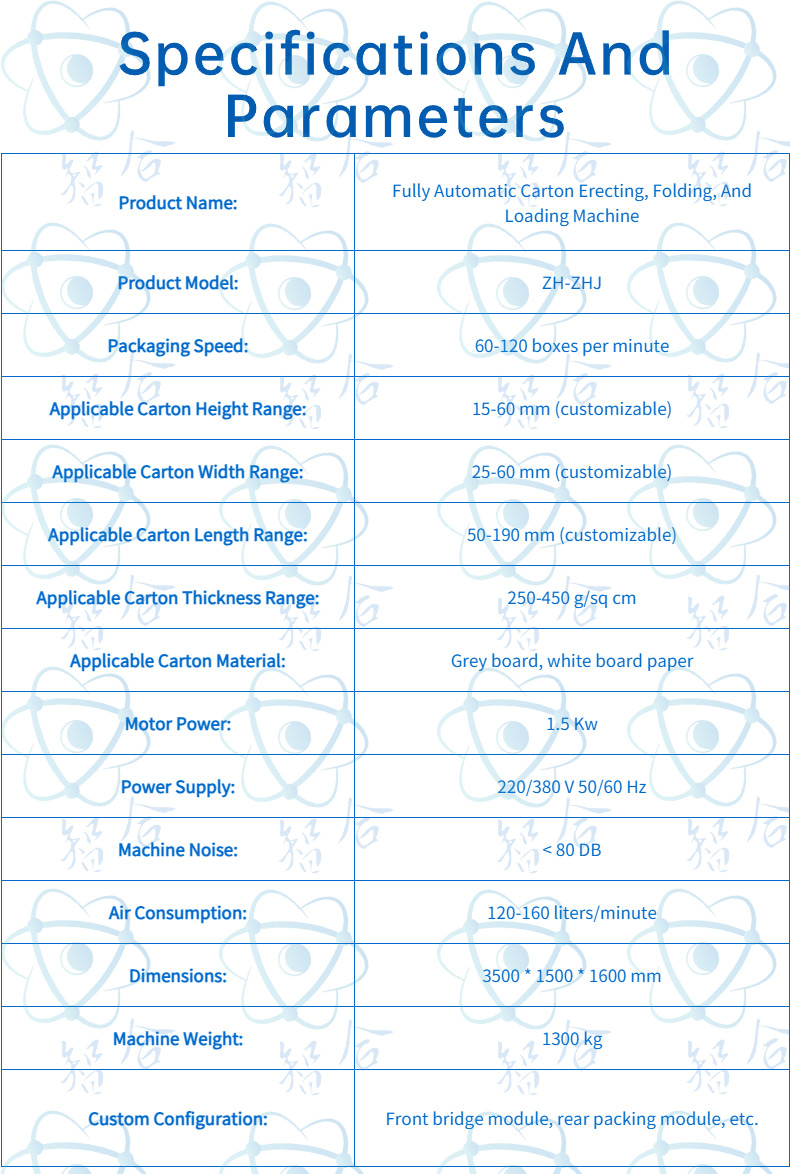
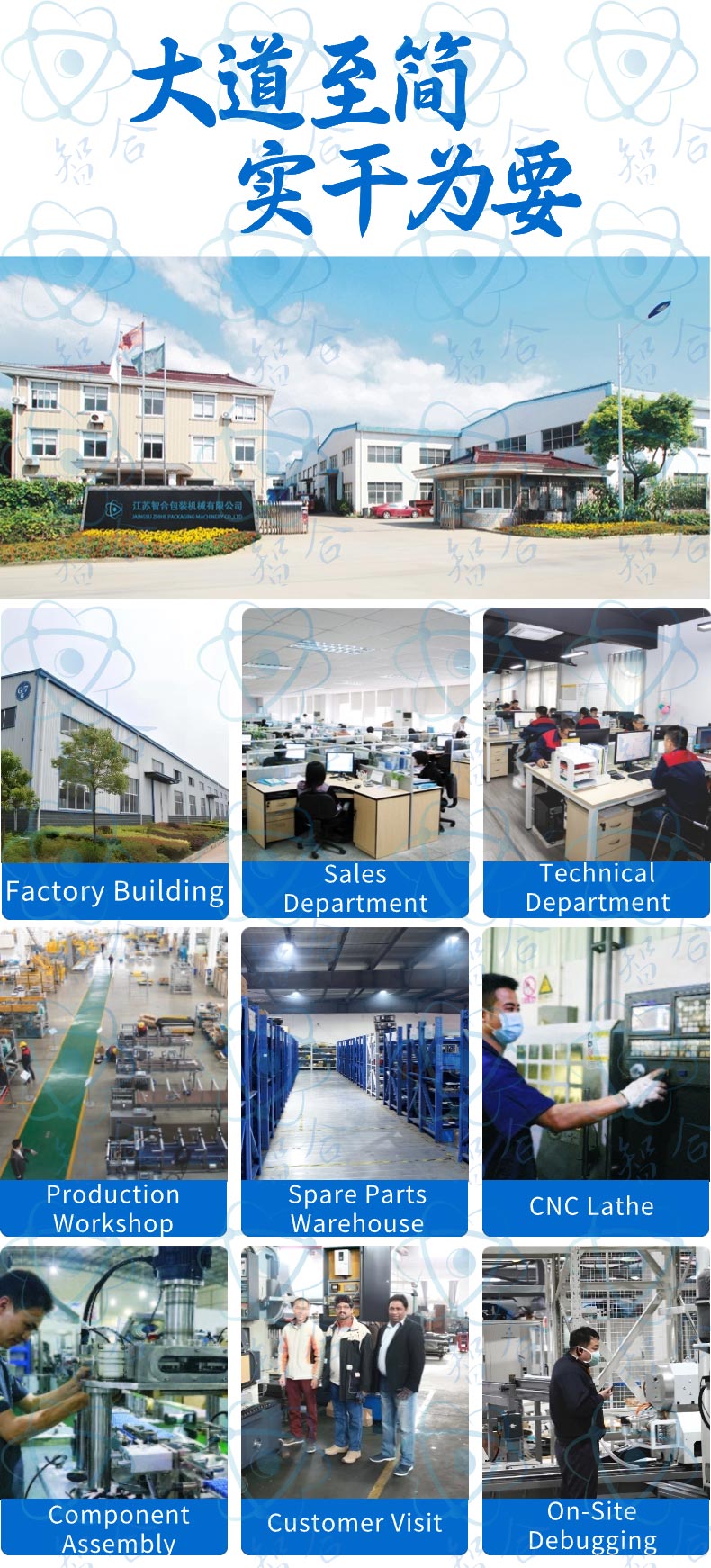
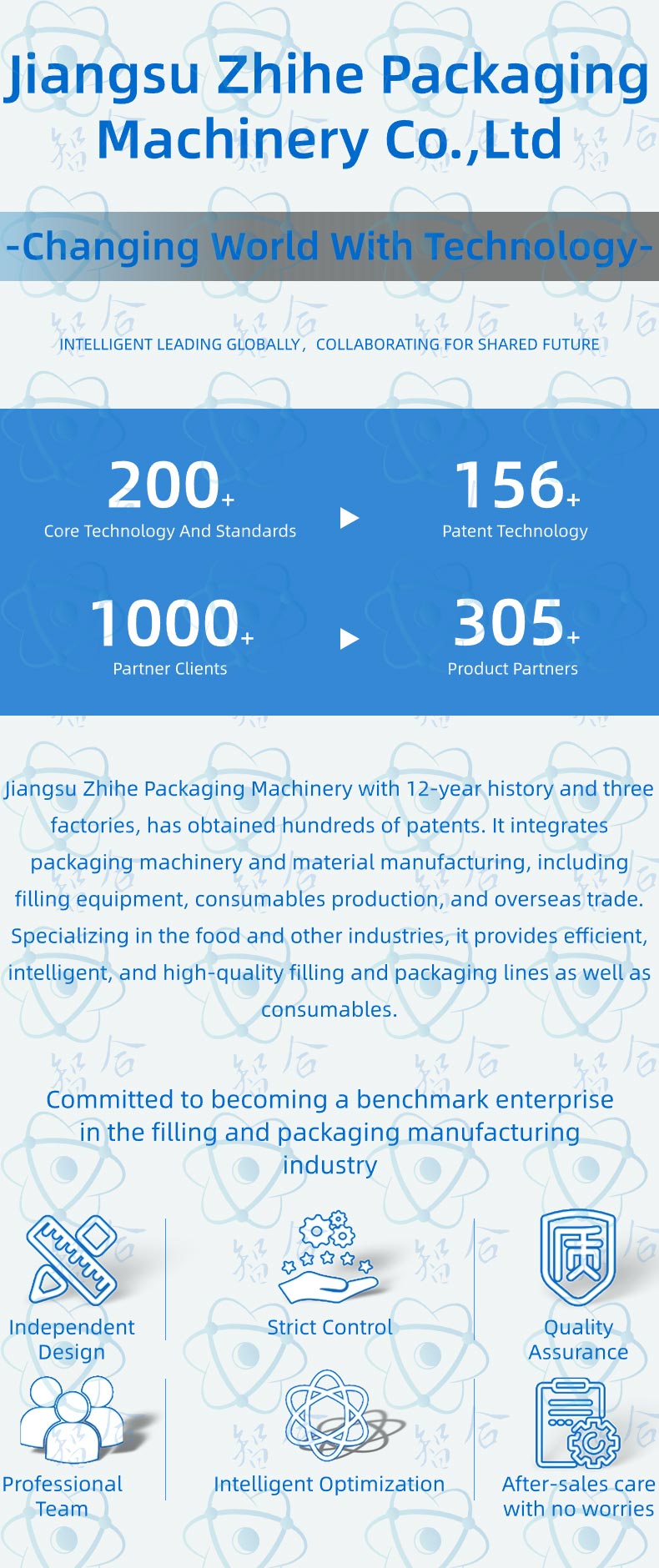
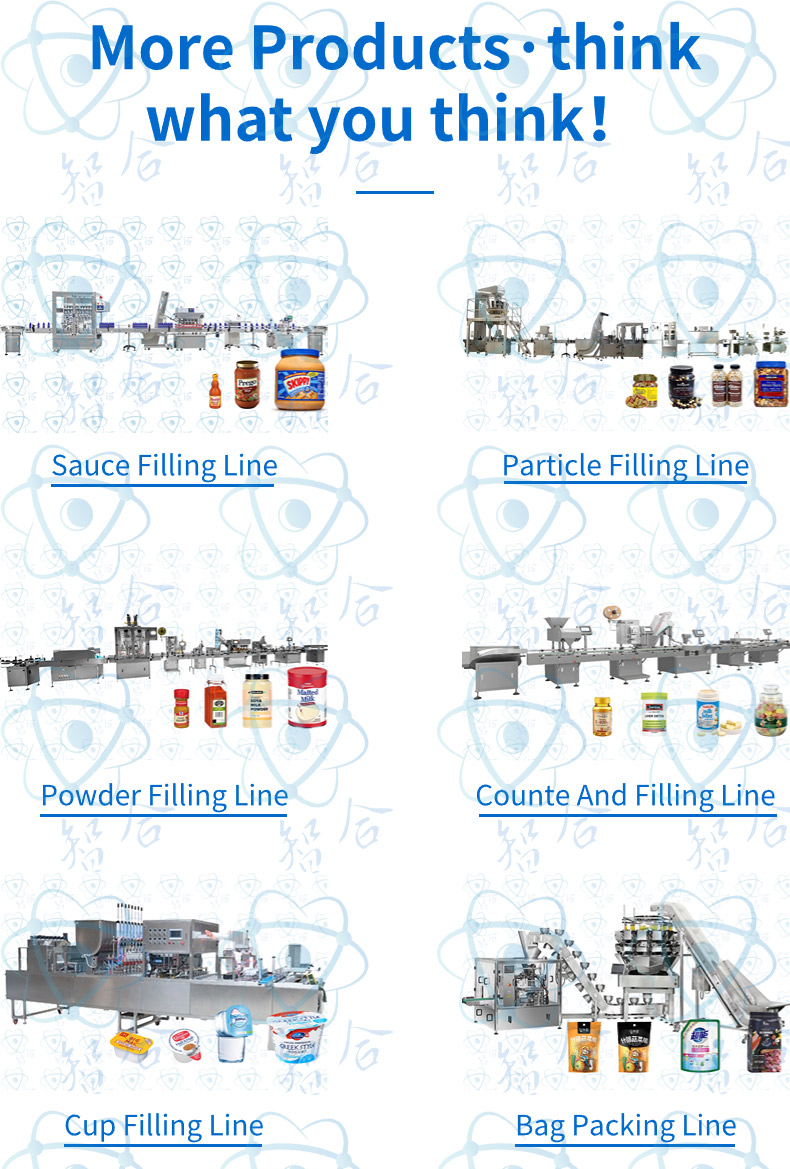
Product Center
